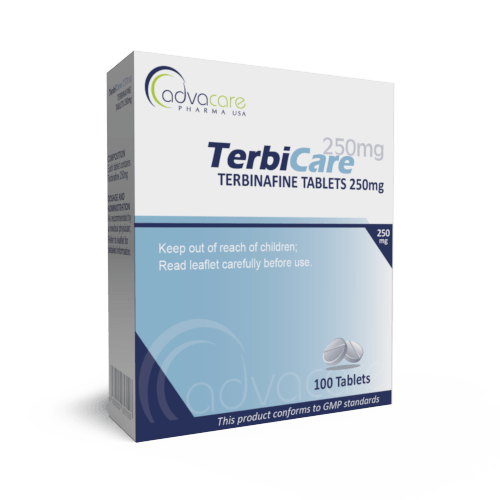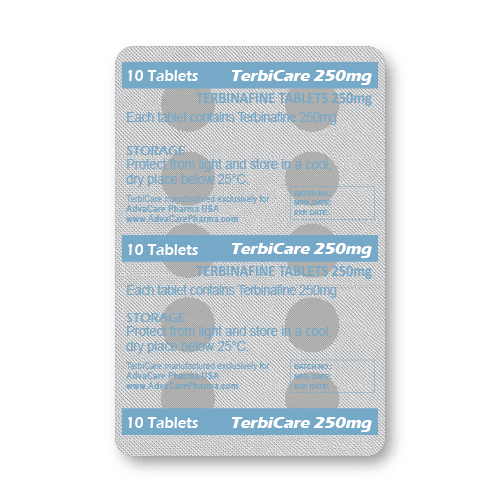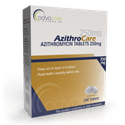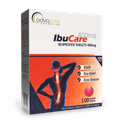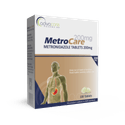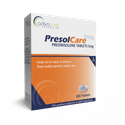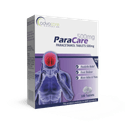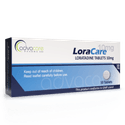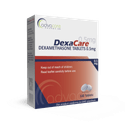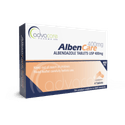- Home›
- Pharmaceuticals›
- Pharmaceutical Tablets›
- Terbinafine Tablets
Terbinafine Tablets
Dosage
Packaging
What is Terbinafine?
Active Ingredients: Terbinafine
Terbinafine Tablets are an antifungal drug used in the treatment of fungal infections of the scalp, skin, and nails, including "jock itch" and "athlete's foot". The active ingredient is effective against fungi belonging to the group Onygenales and some Candida yeast, such as Candida glabrata.
Terbinafine belongs to a class of drugs known as allylamine antifungals. The active ingredient works by stopping squalene epoxidase, which inhibits ergosterol synthesis.
AdvaCare is a GMP-certified producer and supplier of Terbinafine Tablets. We offer a wide range of high-quality and cost-effective medications that are available for distribution. Our pharmaceutical products are manufactured in our GMP-certified facilities in China, India, and the USA.
Why choose us as your Terbinafine manufacturer?
AdvaCare Pharma is a trusted Terbinafine manufacturer committed to providing quality-assured, cost-effective pharmaceuticals for an ever-changing global market. Manufacturing a wide range of 200+ pharmaceutical products in tablet form, we ensure that all of our oral solid dosage forms adhere to stringent GMP standards.
We operate according to a unique "vested supplier-distributor relationship" business model, in which we tie our success in a market to that of our distributor. Such a model facilitates a closer relationship by working together to achieve pre-defined goals for market entry and expansion. As a Terbinafine manufacturer and global supplier, we implement unique strategies to ensure successful distribution.
Uses
What is Terbinafine used for?
It is used to treat fungal infections of the skin and nails, such as “jock itch” and “athlete's foot”.
How should Terbinafine Tablets be used?
This medication is intended to be taken orally. The tablets may be taken with or without food.
Can Terbinafine be stopped if the infection has cleared?
This medication should be taken for the full prescribed time, even if the symptoms improve or the infection is gone. Stopping treatment early or skipping doses may increase the risk of developing another infection that is resistant to Terbinafine.
How should Terbinafine Tablets be stored?
The tablets should be kept in their original packaging until use. It is recommended to keep this medicine in a place that is protected from moisture, direct light, or heat.
What dose should be taken?
Adult Dosing Recommended dosage may vary based on different medical conditions:
- For onychomycosis (fingernails), the usual dose is 250mg taken each day. The duration of treatment is 6 weeks.
- For onychomycosis (toenails), the usual dose is 250mg taken each day. The duration of treatment is 12 weeks.
- For tinea corporis or cruris (off-label), the usual dose is 250mg taken once per day or divided and taken 2 times per day. Treatment should continue for 2-4 weeks.
- For tinea pedis (off-label), the usual dose is 250mg taken once per day or divided and taken 2 times per day. Treatment should continue for 2-6 weeks.
- For cutaneous or lymphocutaneous sporotrichosis (off-label), the usual dose is 500mg taken 2 times per day. Treatment should continue for 2-6 weeks after all lesions have healed. The entire duration may last for 3-6 months.
Renal Dosing Dosing adjustment guidelines have not been defined. The use is not recommended if CrCl < 50ml/min.
Hepatic Dosing This drug is not recommended for use in patients with chronic or active liver disease.
Pediatric Dosing For onychomycosis (fingernails), the usual dose for pediatric patients over 2 years old is based on body weight:
- < 20kg: 62.5mg taken once each day
- 20-40kg: 125mg taken once each day
- > 40kg: 250mg taken once each day
For onychomycosis (toenails), the usual dose for pediatric patients over 2 years old is based on body weight:
- < 20kg: 62.5mg taken once each day
- 20-40kg: 125mg taken once each day
- > 40kg: 250mg taken once each day
For tinea capitis (off-label), the usual dose for pediatric patients over 4 years old is based on body weight:
- < 25kg: 125mg taken once each day
- 25-35kg: 187.5mg taken once each day
- > 35kg: 250mg taken once each day
For tinea corporis (off-label), the usual dose for pediatric patients over 2 years old is based on body weight:
- < 20kg: 62.5mg taken once each day
- 20-40kg: 125mg taken once each day
- > 40kg: 250mg taken once each day
For tinea cruris (off-label), the usual dose for pediatric patients over 2 years old is based on body weight:
- < 20kg: 62.5mg taken once each day
- 20-40kg: 125mg taken once each day
- > 40kg: 250mg taken once each day
For tinea pedis (off-label), the usual dose for pediatric patients over 2 years old is based on body weight:
- < 20kg: 62.5mg taken once each day
- 20-40kg: 125mg taken once each day
- > 40kg: 250mg taken once each day
Renal Dosing for pediatrics Dosing adjustment guidelines have not been defined.
Hepatic Dosing for pediatrics This drug is not recommended for use in children with hepatic impairment.
The exact dosage is dependent on medical condition, response to treatment, age, and weight. Refer to a doctor or pharmacist for guidelines on dosage. Do not exceed what they advise.
What happens if a dose is missed?
The missed dose should be taken as soon as it is remembered. If it is nearly time for the next scheduled dose, then the missed dose should be skipped. Never take 2 doses at the same time.
Who can use Terbinafine?
Terbinafine Tablets can be given to adults and children, but caution is advised for specific group of patients.
Pregnant Terbinafine can be used in pregnancy if there is a clear need. There is no known risk of fetal harm based on limited human data and animal data (at 12-23x the maximum recommended human dosage).
Breastfeeding The benefits must be weighed against the risks when using this drug while breastfeeding. Terbinafine is known to pass in milk. There is no human data available to evaluate the risk of infant harm or the effects of this drug on milk production.
Children Appropriate studies have not been conducted for the safety and efficacy of this drug. However, studies to date have shown effective treatment for fungal infections in pediatric patients over the age of 4 years old. As dosing is determined by body weight, other forms of Terbinafine may be more suitable for young children who are also unable to swallow tablets.
Geriatric Studies have not indicated problems that are specific to this population.
Other warnings
It is advised to confirm diagnosis before beginning treatment, due to the potential toxicity of this Terbinafine.
If patients develop liver disease, neutropenia (abs neutrophil count greater than 1000mcL), skin rash, or any signs of SLE, treatment with this drug should be discontinued.
If patients experience changes in the ocular lens or retina, it may be necessary to discontinue treatment with Terbinafine.
For patients with renal or hepatic impairment, caution is advised.
Routine liver function tests are recommended during treatment with Terbinafine.
Side Effects
As with all pharmaceuticals, some unwanted effects can occur from the use of Terbinafine Tablets.
Common side effects include but may not be limited to:
- headache
- indigestion
- diarrhea
- itching
- abnormal liver function tests
Seek emergency medical treatment if any sign of an allergic reaction occurs.
Drug reaction symptoms may appear several weeks after beginning treatment with this medicine. Seek medical attention if the following symptoms of a drug reaction appear:
- skin rash
- fever or flu-like symptoms
- excessive tiredness or severe weakness
- dark urine
- jaundice (yellowing of the skin or eyes)
- unusual bruising
Call a doctor in the event of symptoms such as:
- mood changes, such as depression, sleep problems, anxiousness, or restlessness
- changes in taste or smell
- weight loss due to loss of appetite or changes in taste
- bloody urine or stools
- swelling or rapid weight gain
- skin sores
- butterfly-shaped skin rash on the cheeks/nose
- pale skin
- easy bruising or unexplained bruising
- purpura
For a comprehensive understanding of all potential side effects, consult a medical professional.
If any symptoms persist or worsen, or you notice any other symptoms, please call your doctor immediately.
Precautions
Do NOT use Terbinafine Tablets if:
- You are allergic or hypersensitive to Terbinafine or any of the other ingredients in the tablet.
- You have active or chronic liver disease.
There are known potential drug interactions with Terbinafine. Consult with your doctor about any current medications before treatment with Terbinafine Tablets.
Terbinafine may not be suitable for people with certain medical conditions. Special considerations, such as regular monitoring or adjusted doses, may be necessary for conditions or circumstances such as:
- hypersensitivity to any other antifungal
- hepatic impairment
- immunodeficiency
- autoimmune diseases such as lupus or psoriasis
- children
- pregnancy
Alcohol should be avoided, as it may worsen the adverse effects caused by Terbinafine.
Caffeine products, such as coffee, tea, or cola, should be avoided during treatment with Terbinafine.
Terbinafine is known to increase sun sensitivity. Patients are recommended to avoid sunlight and artificial UV light exposure while being treated with this medicine.
References
Combination of pulse therapy with terbinafine tablets and topical terbinafine cream for the treatment of dermatophyte onychomycosis: A pilot study
This pilot study evaluated the safety and effectiveness of pulse therapy using terbinafine tablets in 66 patients diagnosed with dermatophyte onychomycosis.
Each pulse consisted of oral terbinafine tablets (500mg/day) administered for one week followed by a three-week interval. Patients also received a topical 1% terbinafine cream that was applied daily. The number of pulses administered was determined based on the improvement observed in the affected nails and patient preference, with a maximum limit of six pulses. Efficacy was evaluated through clinical and mycological examinations conducted one year after initiating treatment.
Complete cure was noted in 51 patients (77.3%), improvements were seen in five patients (7.6%), and slight improvement in one patient (1.5%). Four patients (6.0%) showed no change in their condition.
The conclusion is that a combination of terbinafine pulse therapy with topical application of terbinafine cream led to safety and efficacy in this pilot study.
Terbinafine 250mg : Why the most common dosse?
Terbinafine 250mg is typically prescribed because it effectively treats fungal infections with a single daily dose. Lower doses, such as Terbinafine 125mg, require multiple doses per day or are more convenient for pediatric patients.

You might be interested in...
Why AdvaCare Pharma?
As an industry leader, we are aware of our responsibility to provide affordable and sustainable solutions to improve healthcare worldwide.
